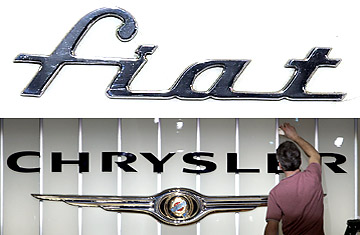
Chrysler didn't just suffer a couple of bad quarters or a bad year in the economic downturn. Its fortunes have been sliding for the better part of five years. Senator John McCain observed last year that no one believed Chrysler could survive, even after getting bailed out by the U.S. Treasury.
Nevertheless, some fresh optimism pervades Chrysler's headquarters and technical centers in Auburn Hills, Mich., where dozens of new employees and engineering consultants have been quietly brought on since last fall to revamp the company's product line, with help from its new Italian partner and parent Fiat.
Starting in late autumn, Chrysler will get its first version of the small Fiat 500 sedan, which will be followed by a convertible, a wagon and a high-performance version, according to TrueCar.com's Jesse Toprak. Chrysler would not confirm these plans. However, the company has announced plans to engineer and produce an electric vehicle using the tiny Fiat 500 platform by 2012. Also in the pipeline is an American version of the Fiat Panda utility vehicle, as well as new midsize and sub-compact cars based on existing Fiat platforms. Fiat will also reportedly provide Chrysler with new minivan, smaller than Chrysler's Town & Country model.
Fiat and Chrysler CEO Sergio Marchionne has also confirmed that Fiat's stylish Alfa Romeo brand will return to the U.S. market with a new sedan and a wagon, which will be distributed through the Chrysler dealer network. "All of the new products that are planned for the U.S. market should help Chrysler reclaim some of their lost market share, particularly in the import-dominated markets like Southern California, New York and surrounding states, and southern Florida," says Toprak. Nevertheless, it will likely be late 2012 before the new Fiat-based Chrysler products appear in sizable numbers at the U.S. dealerships.
To hold the fort until then, Chrysler executives are counting on the redesigned 2011 Jeep Grand Cherokee, which is scheduled to debut in early summer, as well as its trucks and minivans. "I really wish them well, but the new Grand Cherokee has to be a home run," says one former Chrysler executive, who argues that Chrysler can no longer cost-cut its way to financial health. "Chrysler needs new product to keep customers interested," he says.
Nevertheless, the cost-cutting is bearing fruit, with tangible signs that the Chrysler Group's health is beginning to improve. For example, the automaker recently repurchased at a nominal price an assembly plant it had originally left behind in bankruptcy to satisfy unpaid creditors. The company posted a $143 million operating profit for the first quarter despite sluggish sales and declining market share. The financial performance was included in a report presented by Fiat, which has not yet integrated Chrysler's finances with its own.
Longer term, Fiat wants to turn Chrysler into an export powerhouse, with a goal of selling as many as 400,000 U.S.–produced vehicles outside of North America annually through Fiat's distribution network, which is particularly strong in markets such as Eastern Europe and South America.
Jeep is probably the Chrysler vehicle with the biggest potential outside the U.S. The Jeep brand was one of the keys to the Fiat-Sollers joint venture that will build up to 500,000 vehicles annually in eastern Russia, says a senior Chrysler/Fiat executive. The deal will benefit Chrysler with licensing income for the Jeep vehicle kits exported to Russia.
Meanwhile, the most promising part of the alliance with Fiat may be the harmonious working relationship developing between Chrysler veterans and their Fiat counterparts. "We understand each other," said one Chrysler executive.
